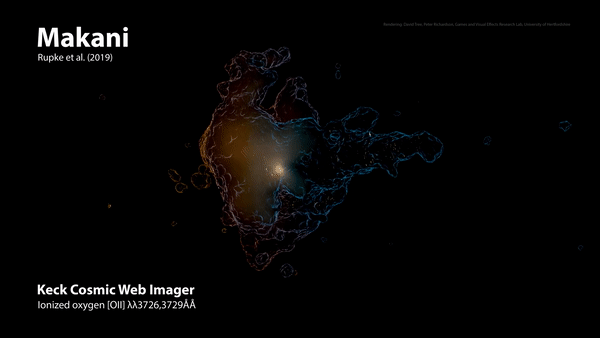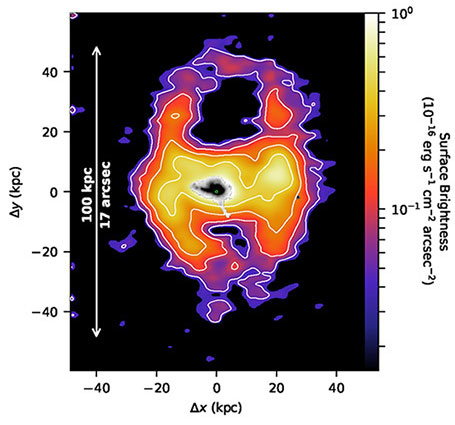For the first time, science has witnessed galactic winds spanning thousands of light years
For the first time, astronomers have witnessed firsthand a huge amount of gas gushing out from a galaxy, a gas line several hundred to thousands of light years long. According to them, this is the first evidence that the galactic wind affects the circumgalactic medium - the huge cloud of gas surrounding the galaxy as they float in the Universe. office. But this discovery is even more significant: the galactic wind shows one of the " cosmic fluctuations" that occur when two galaxies collide.
The galaxy is under study, with the scientific name SDSS J211824.06 + 001729.4 and the nickname Makani (i.e. 'wind' in the Hawaiian language) is not an ordinary galaxy. It was the result of a collision between two giant galaxies, now 'home' , fused together into one 'super-massive' galaxy .

Galaxies can be compared to duckweed floating in the endless sea of space. There will be times when the two galaxies come together due to the influence of gravity, but the two galaxies are not two solid masses colliding with each other and crumbling, but instead, they will merge into one.
Science has witnessed many different stages of this merger. In Makani's case, we see that the merging process is complete, the two galaxies have entered the final stage. Chances are that's why gas - galactic wind is coming out of Makani.

Galactic winds surround Makani.
' The merging galaxies often accompany the starburst event, when a large amount of gas is forced when the two galaxies merge, we will see a series of newly formed stars ', astrophysicist Alison Coil explains. like. 'Those new stars, in the case of Makani, for example, are more likely to create a giant stream of gas - either appear in the form of galactic winds, or explode supernovae when the star dies .'
Using the Keck Space Network Imaging Technology, the team was able to map areas of high temperatures, containing ionized oxygen gas about 4,900 square kiloparsec, or 52 billion square light years. .
Galactic winds can create beautiful shapes like this.
From this area, two streams of gas containing many metals form a gas bubble shaped like an hourglass, hot to 10,000 degrees K. According to the initial observation, two gas streams appear at two different times. .
The earlier stream has existed for 400 million years, and is flowing into space at a speed of 1,400 km / s. The gas line 'born after late birth' goes in the opposite direction, appearing about 7 million years ago, drifting "indifferently" at a speed of 2,100km / s.
' The older gas stream has traveled a very far distance, while the new, slightly faster flow has not been there, ' said physicist David Rupke.
To get the missing pieces and build the panorama, the team needed data from the Hubble Telescope and the Atacama Large Millimeter Radio Antenna Antenna (ALMA). Hubble is responsible for pointing out the stars within the range of their observations, defining their mass, size, and influence, to obtain research data on the final merging phase of the two galaxies. Data from ALMA will show the age of the stars inside the new galaxy.
Last year, there were two relevant scientific reports showing that galactic wind might be the source of the circumgalactic medium gas cloud , the other study shows the gas flows when two galaxies fusion will increase the metality of circumgalactic medium.

Galaxy.

Andromeda Galaxy.
Waves start from the wind, and where does the galactic wind start from? The size and velocity of the gas bubbles are proportional to the wind generated by the giant star structures, obtained after the merging of the two galaxies, and also coincide with the sizes of the galactic winds. we see in the simulation environment.
Science has also seen this hourglass-like appearance when two streams of gas mix, but the galactic wind that Makani produces is unprecedented. This is the evidence linking galactic wind with the characteristics of circumgalactic medium.
' This means we can confirm that the gas emitted from the galaxy flows into the bubble of gas surrounding the galaxy, continuing to take more gas from the inside to carry out ,' Professor Rupke explained. . ' The amount of gas released is enormous - at least 1 to 10% of the galaxy's visible mass - and the gas escapes at a very fast rate, a few thousand kilometers per second .'
Not to mention galactic winds create beautiful images as well. We wait until the day the Galaxy collides with Andromeda, to be able to witness this phenomenon at close range, not to strain our eyes to see the astronomical event taking place in some remote corner of the Universe.
- Detecting exotic galaxies, about 359 million light-years from Earth
- The bridge of gas over 2.6 million light years
- The mystery of 'Phoenix light' for 20 years has yet to be solved
- Mysterious glare in the sky of Russia
- Indonesia unifies the time zone
- Detecting the galaxy seems to not exist
- Announcing the new map of Milky Way 187 million pixels
- Xuyen is not real and this is the only one who can experience it
- New way to filter light
- Measure the distance between stars
- Capture 'light' form in both wave and particle form
- Unexpected disclosure of galactic nuclei
 Van Allen's belt and evidence that the Apollo 11 mission to the Moon was myth
Van Allen's belt and evidence that the Apollo 11 mission to the Moon was myth The levels of civilization in the universe (Kardashev scale)
The levels of civilization in the universe (Kardashev scale) Today Mars, the sun and the Earth are aligned
Today Mars, the sun and the Earth are aligned The Amazon owner announced a secret plan to build a space base for thousands of people
The Amazon owner announced a secret plan to build a space base for thousands of people